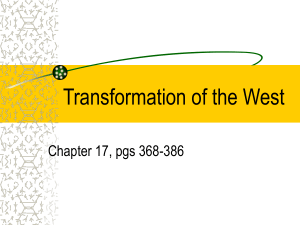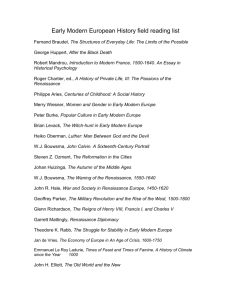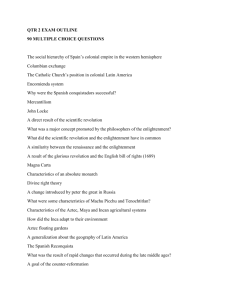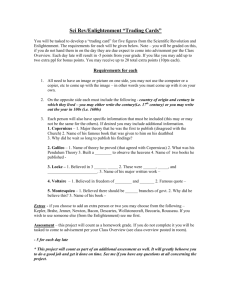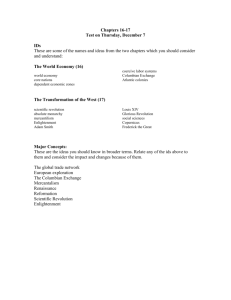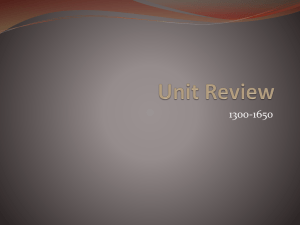Transformation of the West: Chapter 17 Reading Guide
advertisement
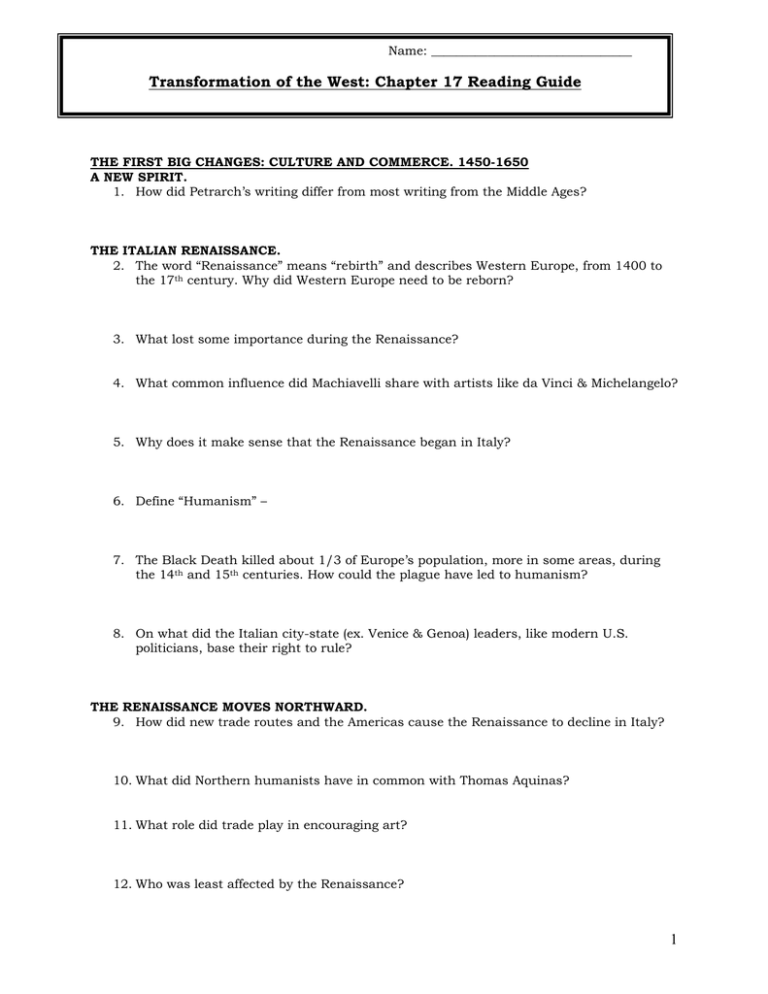
Name: ________________________________ Transformation of the West: Chapter 17 Reading Guide THE FIRST BIG CHANGES: CULTURE AND COMMERCE. 1450-1650 A NEW SPIRIT. 1. How did Petrarch’s writing differ from most writing from the Middle Ages? THE ITALIAN RENAISSANCE. 2. The word “Renaissance” means “rebirth” and describes Western Europe, from 1400 to the 17th century. Why did Western Europe need to be reborn? 3. What lost some importance during the Renaissance? 4. What common influence did Machiavelli share with artists like da Vinci & Michelangelo? 5. Why does it make sense that the Renaissance began in Italy? 6. Define “Humanism” – 7. The Black Death killed about 1/3 of Europe’s population, more in some areas, during the 14th and 15th centuries. How could the plague have led to humanism? 8. On what did the Italian city-state (ex. Venice & Genoa) leaders, like modern U.S. politicians, base their right to rule? THE RENAISSANCE MOVES NORTHWARD. 9. How did new trade routes and the Americas cause the Renaissance to decline in Italy? 10. What did Northern humanists have in common with Thomas Aquinas? 11. What role did trade play in encouraging art? 12. Who was least affected by the Renaissance? 1 CHANGES IN TECHNOLOGY AND FAMILY. 13. How was Johannes Gutenberg important to both the Renaissance and literacy? 14. Describe the European family model and how it limited birthrates? (You have to THINK for that last part. Consider the traditions and advantages of extended families.) THE PROTESTANT AND CATHOLIC REFORMATIONS. 15. What are “indulgences”? 16. List some of the demands Luther included in his 95 Theses. 1. 2. 3. 4. 17. Why did German princes support Luther’s ideas? 18. What is “Protestantism” and what is the key difference with Catholic beliefs. 19. How did Protestant beliefs support trade in Europe? 20. What was the key idea of John Calvin? 21. How did Calvinism help promote the idea that the people should participate in government? 22. What part of Europe did the Catholic Church manage to hang on to? THE END OF CHRISTIAN UNITY IN THE WEST. 23. What was a key outcome of the Protestant and Catholic Reformation in Europe? 2 24. In England in the mid 1600s, King Charles I was Catholic. This contributed to the English Civil War. What was the result? 25. What country declined as a result of the religious strife in Europe? 26. Your text states that people became less likely to see a connection between God and nature during this time. How might the bubonic plague have played a part in that? 27. In what ways did Protestantism both help and hurt the plight of women? 28. What two things came together to promote literacy in Europe? THE COMMERCIAL REVOLUTION. 29. What led to European trade rising along with a greater variety of available goods? 30. How did mercantilism stimulate manufacturing and who benefitted? 31. How did Western European peasants begin to differ economically from Eastern European peasants as a result of trade? SOCIAL PROTEST. 32. What is the “proletariat”? 33. Where did some poor people end up as they sold or lost their land to landowners? 1. 2. 3. 34. Cite evidence of growing class tension in Europe. (This tension will be very important to both the French Revolution later and the work of Karl Marx on Communism.) 35. How were women singled out for punishment in W. Europe during the 17th century? 3 SCIENCE AND POLITICS: THE NEXT PHASE OF CHANGE. 36. Define “Scientific Revolution” – DID COPERNICUS COPY? 37. Copernicus developed the heliocentric theory of planetary motion. What is that theory? 38. Cite one supporting fact that Copernicus DID copy. 39. Cite one supporting fact that Copernicus did NOT copy. SCIENCE: THE NEW AUTHORITY. 40. How was Kepler a product of both the new and old ways of thinking about the universe? 41. Who did Galileo get into trouble with because of his support for Copernicus’ ideas? 42. How did Isaac Newton contribute to science? 43. How did science help women? 44. What was the basic difference between the Christian view of human nature and the humanist intellectuals of the Scientific Revolution? ABSOLUTE AND PARLIAMENTARY MONARCHIES. 45. How did the relationship between nobles and monarchs change following the religious wars in Europe? 46. The necessity of bigger militaries led to what regarding taxes? 47. What did the French system of royal power come to be called? Why? 48. How did Britain differ from France regarding monarchial power? 4 49. The Glorious Revolution in England (shortly after the English Civil War) led to who assuming the dominate role in government? 50. John Locke argued that power comes from where? 51. If a government fails to protect the natural rights of the people, the people had the right to do what, according to Locke? THE NATION-STATE. 52. Welcome to a very difficult but important concept: the “nation-state”. Define what a nation-state is and then explain why the Roman Empire was not a nation-state. 53. How did the role of government change as the notion of nation-states emerged? THE WEST BY 1750. POLITICAL PATTERNS. 75. How did France’s “absolute monarchy” start to become not so “absolute” in the 18th c? 76. How did the Columbian Exchange play a role in the public policy of Fredrick the Great? 77. What would a Confucianist say about the concept of “enlightened depots”? ENLIGHTENMENT THOUGHT AND POPULAR CULTURE. 78. In what country was the Enlightenment centered? 79. What was the basic idea behind the Enlightenment’s application to society? 80. What were some of the public policy changes as a result of Enlightenment ideas? 81. What was Adam Smith’s idea about competition and government? 5 82. List the basic Enlightenment principles of human affairs: a. b. c. – d. 83. Why do you think the Catholic Church was singled out for attack by Enlightenment writers? 84. What was Mary Wollstonecraft’s contribution to the Enlightenment? 85. How did life for children change during and after the Enlightenment? ONGOING CHANGE IN COMMERCE AND MANUFACTURING. 86. How did common people in Western Europe encourage their countries to seek out and exploit colonies? 87. The system of domestic manufacture discussed on p. 385 is known as the “putting-out system”, “cottage industry”, or “workshop system”. Describe how it worked. 88. Better food supplies had a positive benefit on Europe. Cite both the benefit and one particularly important source of food for poor people: 89. Manufacturing jobs helped what class of people? How was this group affected? INNOVATION AND INSTABILITY. No questions – read it though as it is a good chapter summary. GLOBAL CONNECTIONS: EUROPE AND THE WORLD. No questions – read it though as it is a good chapter summary. 6
